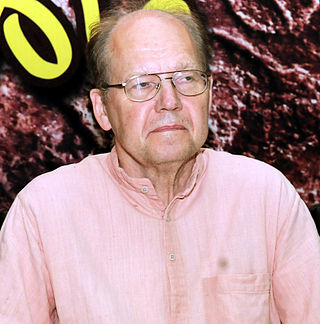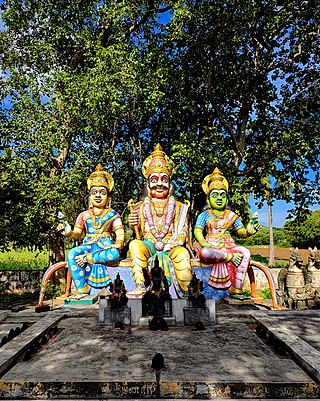
Brahui is a Dravidian language spoken by the Brahui people who are mainly found in the central Balochistan Province of Pakistan, with smaller communities of speakers scattered in parts of Iranian Baluchestan, Afghanistan, and Turkmenistan and by expatriate Brahui communities in Iraq, Qatar, and the United Arab Emirates. It is isolated from the nearest Dravidian-speaking neighbouring population of South India by a distance of more than 1,500 kilometres (930 mi). The Kalat, Khuzdar, Mastung, Quetta, Bolan, Nasirabad, Nushki, and Kharan districts of Balochistan Province are predominantly Brahui-speaking.

The Dravidian languages are a family of languages spoken by 250 million people, mainly in southern India, north-east Sri Lanka, and south-west Pakistan, with pockets elsewhere in South Asia.

Tamil is a Dravidian language natively spoken by the Tamil people of South Asia. Tamil is an official language of the Indian state of Tamil Nadu and union territory of Puducherry, and the sovereign nations of Sri Lanka and Singapore. Tamil is also spoken by significant minorities in the four other South Indian states of Kerala, Karnataka, Andhra Pradesh and Telangana, and the Union Territory of the Andaman and Nicobar Islands. It is also spoken by the Tamil diaspora found in many countries, including Malaysia, Myanmar, South Africa, United Kingdom, United States, Canada, Australia, New Zealand, United Arab Emirates, Saudi Arabia, France, Germany, Italy, Indonesia, and Mauritius. Tamil is also natively spoken by the Sri Lankan Moors. One of 22 scheduled languages in the Constitution of India, Tamil was the first to be classified as a classical language of India.

The Elamo-Dravidian language family is a hypothesised language family that links the Elamite language of ancient Elam to the Dravidian languages of South Asia. The latest version (2015) of the hypothesis entails a reclassification of Brahui as being more closely related to Elamite than to the remaining Dravidian languages. Linguist David McAlpin has been a chief proponent of the Elamo-Dravidian hypothesis, followed by Franklin Southworth as the other major supporter. The hypothesis has gained attention in academic circles, but has been subject to serious criticism by linguists, and remains only one of several possible scenarios for the origins of the Dravidian languages. Elamite is generally accepted by scholars to be a language isolate, unrelated to any other known language.
Mleccha is a Sanskrit term, referring to those of an incomprehensible speech, foreign or barbarous invaders as distinguished from Aryan Vedic tribes.
Jim G. Shaffer is an American archaeologist and professor of anthropology at Case Western Reserve University.
Proto-Dravidian is the linguistic reconstruction of the common ancestor of the Dravidian languages native to the Indian subcontinent. It is thought to have differentiated into Proto-North Dravidian, Proto-Central Dravidian, and Proto-South Dravidian, although the date of diversification is still debated.

Asko Parpola is a Finnish Indologist, current professor emeritus of South Asian studies at the University of Helsinki. He specializes in Sindhology, specifically the study of the Indus script.

Since the Iron Age in India, the native languages of the Indian subcontinent are divided into various language families, of which the Indo-Aryan and the Dravidian are the most widely spoken. There are also many languages belonging to unrelated language families such as Munda and Tibeto-Burman, spoken by smaller groups.

The Northern Dravidian languages are a branch of the Dravidian languages that includes Brahui, Kurukh and Malto.. It is further divided into Kurukh–Malto and Brahui.
Vedic Sanskrit has a number of linguistic features which are alien to most other Indo-European languages. Prominent examples include: phonologically, the introduction of retroflexes, which alternate with dentals, and morphologically, the formation of gerunds. Some philologists attribute such features, as well as the presence of non-Indo-European vocabulary, to a local substratum of languages encountered by Indo-Aryan peoples in Central Asia (Bactria-Marghiana) and within the Indian subcontinent during Indo-Aryan migrations, including the Dravidian languages.

Indigenous Aryanism, also known as the Indigenous Aryans theory (IAT) and the Out of India theory (OIT), is the conviction that the Aryans are indigenous to the Indian subcontinent, and that the Indo-European languages radiated out from a homeland in India into their present locations. It is a "religio-nationalistic" view on Indian history, and propagated as an alternative to the established migration model, which considers the Pontic–Caspian steppe to be the area of origin of the Indo-European languages.

The Dravidian peoples are an ethnolinguistic supraethnicity composed of many distinct ethnolinguistic groups native to South Asia. They speak the Dravidian languages, which have a combined total of about 250 million native speakers. Dravidians form the majority of the population of South India and Northern Sri Lanka.

The Harappan language is the unknown language or languages of the Bronze Age Harappan civilization. The Harappan script has long defied attempts to read it, and therefore the language remains unknown. The language being unattested in any readable contemporary source, hypotheses regarding its nature are reduced to purported loanwords and substratum influence, the substratum in Vedic Sanskrit and a few terms recorded in Sumerian cuneiform, in conjunction with analyses of the undeciphered Indus script.

Old Tamil is the period of the Tamil language spanning from 300 BCE to 700 CE. Prior to Old Tamil, the period of Tamil linguistic development is termed as Pre Tamil. After the Old Tamil period, Tamil becomes Middle Tamil. The earliest records in Old Tamil are inscriptions from between the 3rd and 1st century BCE in caves and on pottery. These inscriptions are written in a variant of the Brahmi script called Tamil Brahmi. The earliest long text in Old Tamil is the Tolkāppiyam, an early work on Tamil grammar and poetics, whose oldest layers could be as old as the mid 2nd century BCE. Old Tamil preserved many features of Proto-Dravidian, the earliest reconstructed form of the Dravidian including inventory of consonants, the syllable structure, and various grammatical features.The Satavahanas also issued bilingual coins featuring Middle Indo-Aryan language on one side, and Desi language on the other side.

The early Dravidian religion constituted a non-Vedic, pre-Indo-Aryan, indigenous religion practiced by Dravidian peoples in the Indian subcontinent that they were either historically or are at present Āgamic. The Agamas are non-Vedic in origin, and have been dated either as post-Vedic texts, or as pre-Vedic compositions. The Agamas are a collection of Tamil and Sanskrit scriptures chiefly constituting the methods of temple construction and creation of murti, worship means of deities, philosophical doctrines, meditative practices, attainment of sixfold desires and four kinds of yoga. The worship of tutelary deities and sacred flora and fauna in Hinduism is also recognized as a survival of the pre-Vedic Dravidian religion. Dravidian linguistic influence on early Vedic religion is evident; many of these features are already present in the oldest known Indo-Aryan language, the language of the Rigveda, which also includes over a dozen words borrowed from Dravidian. The linguistic evidence for Dravidian impact grows increasingly strong as one moves from the Samhitas down through the later Vedic works and into the classical post-Vedic literature. This represents an early religious and cultural fusion or synthesis between ancient Dravidians and Indo-Aryans that went on to influence Indian civilisation.
Franklin C. Southworth is an American linguist and Professor Emeritus of South Asian linguistics at the University of Pennsylvania.
Malaysian Tamil, also known as Malaya Tamil, is a local variant of the Tamil language spoken in Malaysia. It is one of the languages of education in Malaysia, along with English, Malay and Mandarin. There are many differences in vocabulary between Malaysian Tamil and Indian Tamil.
Tamil loanwords entered the Greek language through the interactions of Mediterranean and South Indian merchants during different periods in history. Most words had to do with items of trade that were unique to South India. There is a general consensus about Tamil loanwords in Ancient Greek, while a few of the words have competing etymologies.
The Inner–Outer hypothesis of the subclassification of the Indo-Aryan language family argues for a division of the family into two groups, an Inner core and an Outer periphery, evidenced by shared traits of the languages falling into one of the two groups. Proponents of the theory generally believe the distinction to be the result of gradual migrations of Indo-Aryan speakers into the Indian subcontinent, with the inner languages representing a second wave of migration speaking a different dialect of Old Indo-Aryan, overtaking the first-wave speakers in the center and relegating them to the outer region.











